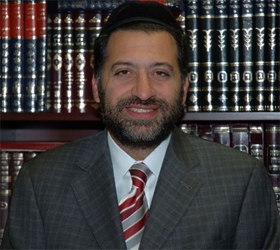The Rambam (Rav Moshe Maimonides, Spain-Egypt, 1135-1204) famously writes that the function of the sounding of the Shofar on Rosh Hashanah is to “awaken” us from our spiritual “slumber.” Over the course of life, we tend to become preoccupied with, and focus our attention on, what the Rambam calls “Hableh Ha’zeman” – the “nonsense” of the world. The sounding of the Shofar is meant to “awaken” us and alert us to the need to devote ourselves to religious observance.
We need to ask, however, how exactly does the Shofar do this? Why must we blow a Shofar to “awaken” us, instead of making some other kind of noise?
In the story of creation in Parashat Bereshit, the Torah tells that G-d created Adam from the dust of the earth, and then, “Va’yipah Be’apav Nishmat Hayim” – “He blew a living soul into his nostrils.” Adam was created as a physical creature – but he was still not complete until G-d “blew” a sacred soul into him.
The Maharal of Prague (Rav Yehuda Loew, 1520-1609) explains that on Rosh Hashanah, the day Adam was created, we blow the Shofar to commemorate the blowing of Adam’s soul into him. This particular act is commemorated to remind us that this is the essence of the human being – his soul. We are shown that although we are both body and soul, the primary component of the human being is the soul.
This is how the Shofar sound “awakens” us. It reminds us of the primacy of the soul. It “awakens” us from the preoccupation with our body, with our physical enjoyment, and reminds us to focus on and sustain the soul.
The Torah tells us in the Book of Debarim (4:4), “And you, who cling to Hashem your G-d – you are all alive this day.” True “life” is achieved when we cling to Hashem, which we do through the performance of Misvot. The Misvot are what nourishes our soul, giving us spiritual life. Even if a person is physically alive, he could be “dead” if his soul, the primary component of his being, is not sustained. And thus the Gemara teaches, “The wicked are considered ‘dead’ even in their lifetime,” and, “The righteous are considered ‘alive’ even after their death.” As far as the body is concerned, of course, “life” is determined by the physical characteristics of life. But in terms of the soul, “life” is determined by the extent of a person’s connection to Hashem, and this connection is built through the performance of Misvot. Hence, a person can be “dead” even during his lifetime, and he can continue to “live” even after death is his soul was properly nourished through Misvot.
The Gemara in Masechet Berachot cites Rabb Akiba’s famous analogy between Torah and water. Just as fish cannot live out of the water, Rabbi Akiba taught, similarly, we cannot live without Torah. Rav Mordechai Gifter (1915-2001) explained that Rabbi Akiba used the specific analogy of fish, because when a fish is removed from the water, it frantically thrashes, until it perishes. During those moments when the fish is thrashing, it appears that it is alive – even more “alive” then it was as it swam peacefully in the water. Of course, this is not the case at all; the thrashing is a sign of the fish’s imminent death. Likewise, Rav Gifter said, many people who live without Torah seem very “alive.” They are involved in many different things, and even seem to enjoy themselves. In truth, however, they are like a fish out of the water. Although their bodies are alive, their souls aren’t – and the primary element of a person’s existence is the soul.
This might be one reason for the custom of Tashlich on Rosh Hashanah. We go to a body of water to observe the fish – to remind ourselves that true life means a life of Torah and Misvot, which is the way we sustain our souls and thereby remain “alive.”
Let us “wake up” and remember to give proper focus and attention to our souls, to Misvot, so that we will be truly “alive” in every sense of the word.










